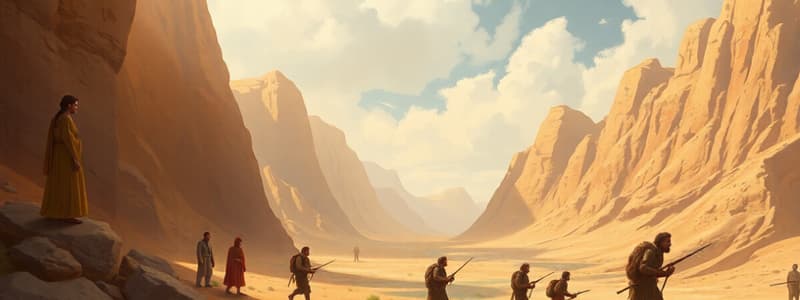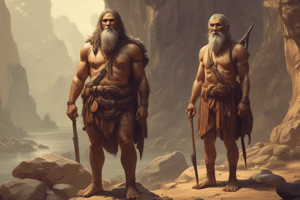Podcast
Questions and Answers
What is the correct order of the prehistoric periods from earliest to most recent?
What is the correct order of the prehistoric periods from earliest to most recent?
- Neolithic, Mesolithic, Paleolithic, Iron Age, Bronze Age
- Bronze Age, Iron Age, Paleolithic, Neolithic, Mesolithic
- Paleolithic, Mesolithic, Neolithic, Bronze Age, Iron Age (correct)
- Iron Age, Bronze Age, Neolithic, Mesolithic, Paleolithic
The Paleolithic Age began approximately 250,000 years ago and ended around 12,000 years ago.
The Paleolithic Age began approximately 250,000 years ago and ended around 12,000 years ago.
True (A)
What were the distinctive artifacts associated with the Clovis peoples?
What were the distinctive artifacts associated with the Clovis peoples?
Spear points and stone tools
The land bridge that formed during the ice age is known as _____
The land bridge that formed during the ice age is known as _____
Which theory proposes that early humans migrated across the Bering Strait?
Which theory proposes that early humans migrated across the Bering Strait?
All archaeological finds indicate that the Clovis peoples were the first to migrate to the Americas.
All archaeological finds indicate that the Clovis peoples were the first to migrate to the Americas.
Name one of the locations where Pre-Clovis remains were found.
Name one of the locations where Pre-Clovis remains were found.
The Ice Age provided both opportunities and _____ for migration.
The Ice Age provided both opportunities and _____ for migration.
Match the terms with their associated time frames:
Match the terms with their associated time frames:
Which period of the Prehistoric era lasted from 250,000 years ago to 5,000 years ago?
Which period of the Prehistoric era lasted from 250,000 years ago to 5,000 years ago?
The Bronze Age directly follows the Paleolithic Age.
The Bronze Age directly follows the Paleolithic Age.
What is the term for the large land bridge that formed during the ice age, which allowed migration to North America?
What is the term for the large land bridge that formed during the ice age, which allowed migration to North America?
The distinctive spear points and stone tools of the Clovis peoples were first discovered near _____, New Mexico.
The distinctive spear points and stone tools of the Clovis peoples were first discovered near _____, New Mexico.
Match the archaeological findings with their relevant dates:
Match the archaeological findings with their relevant dates:
During which age did Earth experience its last ice age?
During which age did Earth experience its last ice age?
Humans migrated to Australia from Indonesia around 40KYA.
Humans migrated to Australia from Indonesia around 40KYA.
What is the time frame of the Iron Age?
What is the time frame of the Iron Age?
The migration theory proposing that early humans crossed the Bering Strait is known as _____ First Theory.
The migration theory proposing that early humans crossed the Bering Strait is known as _____ First Theory.
Which of the following statements is true regarding the evidence against the Clovis First Theory?
Which of the following statements is true regarding the evidence against the Clovis First Theory?
Flashcards are hidden until you start studying
Study Notes
Prehistoric Period Overview
- Spanning from 250,000 years ago (KYA) to 3,000 years ago (YA), this period lacks written records.
- Divided into three main eras: Stone Age, Bronze Age, and Iron Age.
Stone Age
- Lasted from 250 KYA to 5 KYA.
- Further categorized into:
- Paleolithic (250 KYA to 12 KYA)
- Mesolithic (12 KYA to 10 KYA)
- Neolithic (10 KYA to 5 KYA)
Paleolithic Age
- Coincided with the last ice age, causing significant extinction events, including large mammals.
- Homo Sapiens faced near extinction but adapted and migrated.
- Ice age dynamics created land bridges while inhibiting migration in certain areas.
Migration to the Americas
- Early humans began migrating from Eurasia to North and South America as the ice age ended.
- Clovis peoples are recognized as the first inhabitants of the Americas.
- Distinctive spear points and tools discovered near Clovis, New Mexico, in the 1920s served as archaeological evidence.
Clovis First Theory
- Proposes migration through the Bering Strait (around 13 KYA) from Siberia to Alaska on foot using the land bridge Beringia.
- Clovis peoples then navigated southward through gaps in the Canadian ice sheets.
Pre-Clovis Evidence
- Findings at several archaeological sites:
- Meadowcroft, Pennsylvania (19 KYA)
- Pedro Furada, Brazil (30 KYA)
- Monteverde, Chile (30 KYA)
- These dates predate the Clovis thought timeline, leading to revised migration theories.
Coastal Route Theory
- Suggests migration by boat around 20 KYA.
- Pre-Clovis peoples likely used canoes from Siberia, traveling along the coastlines of North America and South America.
Solutrean Hypothesis
- Proposes that around 21 KYA, people from the Solutré region of France migrated to North America via Atlantic pack ice.
- Similar tools found in both Solutrean and North American sites strengthen this hypothesis.
Theories' Interconnectedness
- Multiple migration routes might have been utilized; Clovis and Pre-Clovis peoples may have arrived in North America through various means, combining overland and maritime routes.
Prehistoric Period Overview
- Spanning from 250,000 years ago (KYA) to 3,000 years ago (YA), this period lacks written records.
- Divided into three main eras: Stone Age, Bronze Age, and Iron Age.
Stone Age
- Lasted from 250 KYA to 5 KYA.
- Further categorized into:
- Paleolithic (250 KYA to 12 KYA)
- Mesolithic (12 KYA to 10 KYA)
- Neolithic (10 KYA to 5 KYA)
Paleolithic Age
- Coincided with the last ice age, causing significant extinction events, including large mammals.
- Homo Sapiens faced near extinction but adapted and migrated.
- Ice age dynamics created land bridges while inhibiting migration in certain areas.
Migration to the Americas
- Early humans began migrating from Eurasia to North and South America as the ice age ended.
- Clovis peoples are recognized as the first inhabitants of the Americas.
- Distinctive spear points and tools discovered near Clovis, New Mexico, in the 1920s served as archaeological evidence.
Clovis First Theory
- Proposes migration through the Bering Strait (around 13 KYA) from Siberia to Alaska on foot using the land bridge Beringia.
- Clovis peoples then navigated southward through gaps in the Canadian ice sheets.
Pre-Clovis Evidence
- Findings at several archaeological sites:
- Meadowcroft, Pennsylvania (19 KYA)
- Pedro Furada, Brazil (30 KYA)
- Monteverde, Chile (30 KYA)
- These dates predate the Clovis thought timeline, leading to revised migration theories.
Coastal Route Theory
- Suggests migration by boat around 20 KYA.
- Pre-Clovis peoples likely used canoes from Siberia, traveling along the coastlines of North America and South America.
Solutrean Hypothesis
- Proposes that around 21 KYA, people from the Solutré region of France migrated to North America via Atlantic pack ice.
- Similar tools found in both Solutrean and North American sites strengthen this hypothesis.
Theories' Interconnectedness
- Multiple migration routes might have been utilized; Clovis and Pre-Clovis peoples may have arrived in North America through various means, combining overland and maritime routes.
Studying That Suits You
Use AI to generate personalized quizzes and flashcards to suit your learning preferences.




